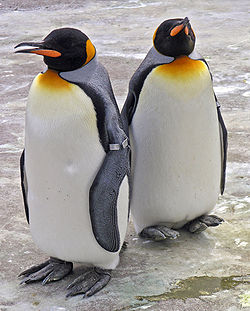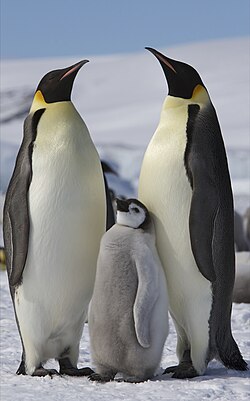| King penguin  | Aptenodytes patagonicus
Miller, JF, 1778
- Aptenodytes patagonicus patagonicus
- Aptenodytes patagonicus halli
| Breeds on the subantarctic islands between 45° and 55° S at the northern reaches of Antarctica, as well as Tierra del Fuego, the Falkland Islands and other temperate islands of the region.
 | Size: 90 cm (3 ft) tall, weighing 11 to 16 kg (24 to 35 lb), The upper parts are steel blue-grey, darkening to black on the head, the belly is white fading to orange on the upper breast with bright orange ear patches. The black bill is long and slender. The lower mandible bears a striking pink or orange-coloured mandibular plate
Habitat:
Diet: | LC
|
|---|
| Emperor penguin  | Aptenodytes forsteri
Gray, 1844 | Circumpolar distribution in the Antarctic between the 66° and 77° S. It almost always breeds on stable pack ice near the coast and wander up to 18 km (11 mi) offshore. [9]
 | Size: 122 cm (4 ft) tall, weighing 22–37 kg (48.5–82 lb), the adult has deep black dorsal feathers, covering: the head, chin, throat, back, dorsal part of the flippers and tail. The underparts of the wings and belly are white, becoming pale yellow in the upper breast, and ear patches are bright yellow. The upper mandible is black and the lower mandible can be pink, orange or lilac. Males and females are similar in size and coloration.
Habitat:
Diet: | NT
|
|---|











